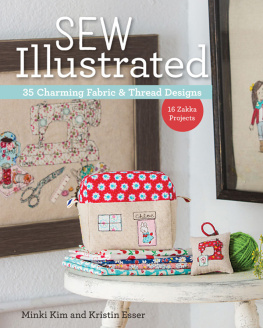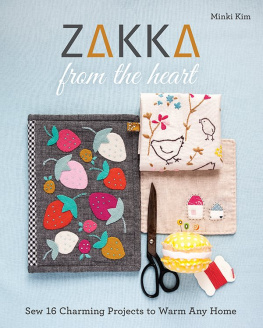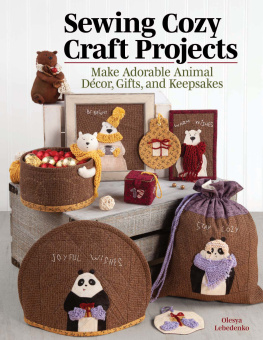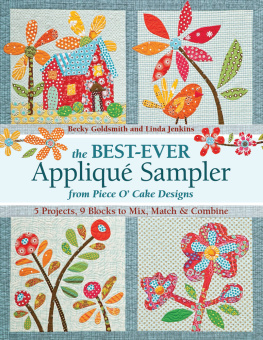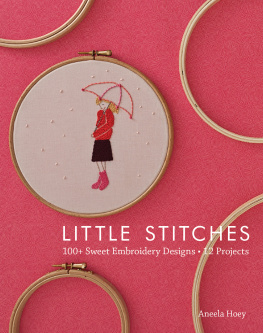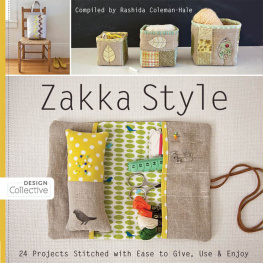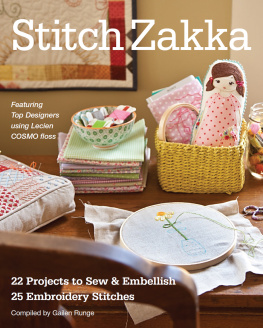Publisher: Amy Marson
Creative Director: Gailen Runge
Project Editor: Lynn Koolish
Technical Editors: Alison M. Schmidt and Debbie Rodgers
Cover/Book Designer: Page + Pixel
Production Coordinator: Zinnia Heinzmann
Production Editors: Jessie Brotman and Alice Mace Nakanishi
Illustrators: Minki Kim and Zinnia Heinzmann
Production Assistant: Carly Jean Marin
Style photography by Page + Pixel and instructional photography by Diane Pedersen, unless otherwise noted
Published by Stash Books, an imprint of C&T Publishing, Inc., P.O. Box 1456, Lafayette, CA 94549
DEDICATION
From Minki:
To my husband, Alex. Thank you for being the same man I met 13 years ago. And my three CsCaylin, Chloe, and Claire. You always make me want to be a better person.
From Kristin:
For Mom, who instilled in me a love of sewing. I miss you every day. And for my familyGary, Chloe, Jonah, and Ben. You are my world.
ACKNOWLEDGMENTS
Writing this book was a dream come true, and there are so many people to thank who made it possible.
First of all, thank you to the wonderful people at C&T Publishing for believing in the idea and helping to make this dream a reality, especially Roxane and Lynn. You were a pleasure to work with.
We owe a debt of gratitude to our pattern testers, Jonal Beck, Philipa Core (Ozzypip), Pamela Edwards, Kristi Ryan, and Vicki Tymczyszyn. Thank you for spending your personal time to make this a better book.
Thank you to the companies that supported us with materials to create these projects: Aurifil, buttons.com, C&T Publishing, DMC, The Fat Quarter Shop, Greyline Linens, Jillibean Soup, Just Another Button Company, Penny Rose Fabrics, Riley Blake Fabrics,
Introduction
A NOTE FROM MINKI
Sewing illustration is my passion, and I could not be more excited to share it with you. I am often asked how the technique is done, and I am so happy to have a whole book explaining it in detail to share with you. My journey to sewing illustration has been a gradual one: I moved to the United States from Korea shortly after getting married, and not knowing anyone here, I began looking for a way to fill the hours. I soon turned to hand sewing, embroidery, and creating handmade dolls as a creative outlet.
One day, my husband brought home a sewing machine, and I found a corner in our tiny apartment to tuck it into. At this point, I had been hand embroidering my drawings and wondered if I could do the same thing with the sewing machine. With some practice, I found that not only could I recreate my drawings on the sewing machine, but it was much faster and I could create even more detailed designs. Soon, I began adding bits of fabric to add interest to my creations, and sewing illustration was born. To this day, I think of sewing illustration as simply drawing with thread.
In the beginning, much of my inspiration came from photos that I took with my phone when I was out on a walk or at the park with my girls. When I returned home, I would head to my sewing area and recreate these images with my sewing machine. About this time I began my Korean blog (blog.naver.com/zeriano) and started creating a new project nearly every day to share with my readers. I soon found that sewing illustration could be used to embellish any type of project, from coasters to zipper pouches to works of art for the living room wall. I eventually started an English blog (minkikim. com) and also began sharing my creations on Instagram. I love these creative outlets and the inspiration and encouragement I get from being a part of the online sewing community.
Perhaps the most important thing that I hope you take away from this book is the importance of taking time to be creative every day. I truly feel that sewing has changed my life and changed how I look at my life. It is so easy to get lost in the busyness of keeping a home and raising children. But I have found that taking time to sew, even if just for a few stolen moments here and thereat the park, at the pool, or at my sewing machineprovides me with the energy to tackle the rest of my day with a smile.
I hope this technique of drawing with thread will open a new door of creativity for you. It has enriched my life in so many ways and I am so happy to share it with you.
Minki
I think of sewing illustration as simply drawing with thread. MINKI
A NOTE FROM KRISTIN
Sewing has been a part of my life for as long as I can remember. My mother made my clothes when I was a toddler, stitched every Halloween costume with love, and even designed and sewed the drapes for our home. As a teenager, I continued this tradition and made clothes, and as a young adult fresh out of college, I happily began sewing for my new apartment. I stitched up all manner of puffy valances, throw pillows, and toaster covers. After I got married and had a family, my interests turned to quilting and creating items for my home. I delighted in seeing my children snuggled on the sofa with a quilt that I had made, bread rising under a hand-embroidered tea towel, and a hand-knit dishcloth in the sink.
One day, when walking my son to school, I noticed that a new family had moved in down the street and there was a sewing machine right there in the window. I decided then and there to befriend this new neighbor. Up until this point I had no real-life sewing or crafting friends. Thanks to the Internet, I was inspired on a daily basis, but I had no one to chat with about this passion. That sewing machine in the window was Minkis, and we became fast friends over many cups of coffee and tea. I was completely amazed when she shared her work with me. I knew then that the sewing community needed to see her work, and we began making plans for this book. It has been my pleasure to help create this book so that you too can make these lovely projects embellished with sewing illustration.
Minki amazes me with her drawings all the time. When we started this book, I was not confident in my drawing skills. However, using the techniques in this book, I have seen my skills improve with each project. You dont have to be able to draw to create these lovely designs. But if you can, you can take what you learn here and use it as a jumping-off point for your own one-of-a-kind creations. My message to you is to enjoy the process, explore this new technique, and embrace taking time out of your day to sew and nurture your creativity.
Kristin
Basic Techniques
Sewing illustration is a fun and versatile technique that you can use to enhance and embellish many types of sewing projects. One of the best things about this technique is that it can be as simple or elaborate as you like. Start with simple designs and projects and watch your skills grow as you work your way through the projects in this book. Then apply the technique to your own projects. The options are endless!
Read through this chapter carefully to understand the basics; then experiment to find the techniques that work best for you.
TIP There are many ways to transfer designs and create fabric accents; you will see these used throughout the book. Try different techniques to find the ones that work best for you.
TRANSFERRING A DESIGN TO FABRIC
The first step in sewing illustration is to transfer a design onto fabric. There are many ways to transfer the designs and motifs provided in this book onto your fabric. Some work better than others, and sometimes the choice is just a matter of personal preference. None of them require a big investment, so you may want to pick up the materials for a few different techniques and experiment to find out what you like best.
IRON-ON TRANSFERS
All the sewing illustration designs are provided as iron-on transfers (pullout pages P1 and P2). These transfers can be used multiple times, but the ink will appear lighter with each use. The ink may fade with time but does not wash out, so make sure to cover the lines with stitching.
Next page
